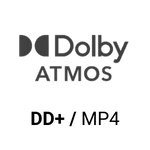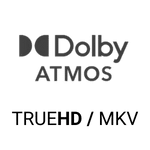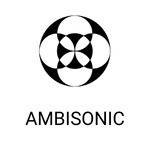Frequently Asked Questions
Answers to common questions about audio formats, technology, experiences, and purchasing options.
Sonic Tools are immersive and unconventional listening experiences from our original catalog.
They can help you shift your emotional state, enhance brain flexibility, and explore new ways of perceiving sound and space.
Available for personal users through our boutique shop, they are also designed for events, spaces, and installations.
We choose not to include video in our MP4 files to keep their size optimized for consumer devices such as soundbars, home speakers, smart speakers, laptops, tablets, and PCs—allowing immersive playback without the need for headphones.
However, in Dolby Atmos TrueHD, select immersive content will include video, delivering a high-quality experience in both sound and visuals.
You can find all of our Sonic Tools and content in specific immersive audio formats exclusively in our shop on our website. On generalist music stores, only a limited selection of our catalog is available in Binaural 3D Audio Format or Spatial Audio (where supported), mainly for promotional purposes or as part of our back catalog.
We use the Dolby Atmos format because it is widely supported across audio devices, ensuring maximum accessibility.
At the same time, we remain open to creating content for emerging immersive audio technologies to expand our offering
WHAT is the right AUDIO FORMAT for me?
Compatibility:
Headphones or earbuds (requires a playback device)
Device that supports MP3 or FLAC playback through headphones or earbuds
XR and VR devices that allow local playback of MP3 and FLAC files
For listening our content with headphones or hearables the audio formats are two : FLAC and MP3.
FLAC (Free Lossless Audio Codec) is a compressed audio format that differs from traditional lossy compression methods. Unlike formats like MP3 or AAC, FLAC is a lossless compression, meaning it retains all the original audio data during compression without sacrificing quality. The compression in FLAC is achieved by encoding redundant data more efficiently rather than discarding it.
MP3 (MPEG-1 Audio Layer 3) format is a widely used audio file format that employs lossy audio compression to reduce the file size while maintaining a good level of sound quality. It was developed by the Moving Picture Experts Group (MPEG) and has become the de facto standard for online digital music files.
Compatibility:
Home Theaters (Optimal use case)
Soundbars & Smart Speakers (Check format compatibility)
PC, Laptops, Tablets & Gaming Consoles (Check format compatibility)
*Check the device specifications to confirm TrueHD support.
TrueHD with Dolby Atmos requires compatible audio and video devices for full utilization. This includes Blu-ray players, AV receivers, soundbars, and home theater systems that support Dolby Atmos and TrueHD.
Many modern media streamers from popular brands such as Nvidia Tv Shield, Apple TV, Roku, Amazon Fire TV, and others often support the “audio passthrough” feature to allow the unaltered transmission of audio to your external audio system.
It is advisable to check the product specifications or device settings to confirm the presence of this function.
MKV (Matroska)
The MKV (Matroska) format is a versatile and open multimedia container well-suited for high-quality audio and video. It is compatible with advanced codecs like Dolby TrueHD, commonly associated with Dolby Atmos.
Some content in our catalog also includes video in 4K resolution, combined with Dolby Atmos TrueHD.
Compatibility:
Soundbars & Smart Speakers
PC, Laptops, Tablets & Gaming Consoles
Home Theaters
MP4 files containing Dolby Atmos Digital Plus (DD+) are designed to deliver an immersive audio experience across a wide range of consumer devices. This format is ideal for streaming platforms and compatible devices, including:
•Soundbars and home theater systems for advanced surround sound.
•Smart speakers and portable devices, including gaming consoles.
•Tablets and PCs/laptops, with support available via media players like VLC or Apple Music.
Dolby Atmos Virtualization for Headphones:
MP4 with Dolby Atmos DD+ also enables spatialized audio playback through standard stereo headphones, thanks to the headphone virtualization feature.
•It’s an ideal solution for consumer devices such as tablets, laptops, or smartphones that support Dolby Atmos.
Tablets and Smartphones:
Compatible tablets and smartphones can leverage Dolby Atmos virtualization for headphones without requiring external devices or complex setups. Apps like Apple Music or VLC provide Dolby Atmos rendering directly on the device.
Compatibility:
XR ( VR MR AR ) Game Developers & 360 Video Makers
Ambisonic format is commonly used in immersive audio productions, such as 360-degree videos, virtual reality (VR), and augmented reality (AR). Its spherical representation offers an engaging and realistic sound experience.
The Ambisonic format is designed to provide a comprehensive and three-dimensional audio representation, making it suitable for a wide range of immersive and professional applications.
Ambisonic orders refer to the number of microphone capsules in a spherical array used to capture three-dimensional audio.
Increasing the order adds more capsules, enhancing precision in spatial audio recording.




How to listen
Check which formats work best with your device
Home Theater Systems – Dolby Atmos in High Resolution
For home theater systems, we offer DOLBY ATMOS for an immersive, three-dimensional sound experience.
- DOLBY ATMOS TrueHD (High Resolution) A lossless format available via Digital Download in MKV, supporting audio-only or video-integrated playback.
- DOLBY ATMOS Digital Plus – A lossy format optimized for streaming, delivered in MP4 for broad device compatibility.
Best for You
TrueHD (High Resolution) – Maximum quality for high-end home theaters.
Digital Plus – Balanced sound for versatile setups.
For smart speakers and soundbars, we offer DOLBY ATMOS Digital Plus in MP4 format, ensuring immersive spatial audio with broad compatibility.
Why Dolby Atmos Digital Plus?
- Wide Compatibility – Works with most smart speakers, soundbars.
- Playback on PCs & Laptops
Modern PCs and laptops can play MP4 files with Dolby Atmos Digital Plus as standalone devices or when connected via HDMI or digital cables to external audio systems such as soundbars or smart speakers.
Dolby Atmos TrueHD requires specific hardware support.
*Check if your device is compatible before attempting playback.
We offer MP4 format for PC, tablets, and laptops because no headphones or wearable devices are required to experience high-quality sound.
Many modern devices support Dolby Atmos with Dolby Digital Plus (E-AC3) natively.
If your device does not support it, you can use a compatible media player to ensure proper playback.
Recommended Media Players for Dolby Atmos MP4:
- VLC Media Player – Universal, free, and supports E-AC3 natively
- Kodi – Ideal for home theater and streaming
- MPV Player – Lightweight, customizable, and supports multiple formats
- Plex with transcoding – Best for multi-device streaming
Dolby Atmos in MP4 is widely accessible. If your device does not support it, these media players provide a simple solution.
For headphones, earbuds, and hearables, we offer Binaural 3D Audio, delivering an immersive spatial listening experience with depth and realism.
This format provides a natural, three-dimensional sound field, perfect for a personal and intimate audio experience.
Our Binaural 3D Audio is available in two formats:
- FLAC (Free Lossless Audio Codec) – High-fidelity, lossless compression for pristine audio quality.
- MP3 (MPEG-1 Audio Layer 3) – Efficient compression for broad compatibility and smaller file sizes.
How It Works
Simply download your preferred format onto your phone, tablet, PC, or multimedia player, then connect your headphones, earbuds, or hearables via wired or wireless connection.
Compatible Playback Devices
Our audio can be played on any device with a headphone connection or wireless pairing, including:
Mobile Phones
Tablets
Laptops & PCs
Multimedia Players
Simple & Universal Compatibility
Since FLAC & MP3 are the standard formats for all XR/VR media players, you can easily enjoy our immersive soundscapes on any device,
just download and play inside your virtual world.
Our Binaural 3D Audio is fully supported on:
- Meta Quest (2, 3, Pro) – Listen via Meta Player or Skybox VR.
- Apple Vision Pro – Compatible with the Files app or Apple Music for direct playback.
- Pico (Pico 4, Neo 3, Neo 4) – Works with Pico Video Player or DeoVR.
- HTC Vive XR Elite & Vive Flow – Play using Vive Video.
- Varjo XR Series – Supports native high-fidelity playback.
- Windows Mixed Reality Headsets – Use the Movies & TV app or third-party media players.
We create sound installations for events and spaces, whether temporary or permanent.
If you are interested in a sound installation for your event or space, contact us.




SHOPPING EXPERIENCE
Select the products you wish to purchase, add them to your cart, and then proceed to checkout. You’ll be prompted to enter your billing information and choose a payment method to complete your order.
Yes, we use SSL encryption to protect your personal information and ensure that your credit card details are secure. We use Stripe as a payment provider.
Yes, we ship to many countries worldwide.
Shipping costs and times may vary depending on your location.
To return an item, please contact our customer service for a return authorisation and instructions on how to send your item back to us.
Once you downloaded a digital file you can not get a full refund anymore.
Refunds are processed upon receipt and inspection of the (returned) item(s). Please allow a certain number of days, usually 5-10 business days, for the refund to be credited to your original payment method.
Unfortunately, you cannot order products that are out of stock. However, you can request to be notified when the item is back in stock.
You can enter your promotional code called coupon code at checkout. The discount will be applied to your total purchase amount.
If you have any issues with your order, please contact our customer service team for assistance. We’re here to help resolve any problems you may encounter.
The download link is immediately accessible on the “Thank you for your order” page and in the download section of your account.
The link is typically sent immediately after the purchase is confirmed. Please allow a few minutes for the email to arrive and check your spam folder if you can’t find it.
Yes, you can download your purchased digital products 2 times. Access your account to find the download links in your order history.
Yes, digital products and specifically audio files are subject to copyright and usage restrictions. You’re allowed to use them for personal use only, unless otherwise specified. Redistribution or resale is strictly prohibited. We sell separate licences for events, spaces and business use. Please contact us for more information.
Due to the nature of digital products, returns are generally not accepted. However, if you experience technical issues or are dissatisfied with your purchase, please contact our customer service for support.
Once you downloaded a digital file you can not get a full refund anymore.
If you’re experiencing difficulties with downloading or accessing your digital product, please ensure you have a stable internet connection and you’re using a compatible device. If problems persist, contact our customer service for assistance.
You can unsubscribe by clicking the “unsubscribe” link at the bottom of any newsletter email.
We accept various payment methods including credit cards (Visa, MasterCard, American Express), PayPal, and sometimes bank transfers or payment upon delivery, depending on the region. We also accept crypto payments.
You can change or cancel your order within 24 hours after placing it. Please contact customer service as soon as possible to make any changes. In the case of a digital order it is important that the product has not been downloaded or opened.
Once your order has been shipped, we will send you a tracking number via email. You can use this number to track your order through the carrier’s website.
We accept returns within 14 days provided the items are in their original condition and have not been used. Please refer to our return policy page for more details.
If your order arrives damaged or defective, please contact us immediately to arrange for a replacement or refund.
Shipping costs vary depending on the size of your order and your location. You can view the shipping costs at checkout before completing your order.
You can create an account by clicking on the my account link or filling in all the details on the checkout page.
After completing your purchase, you’ll receive an email with a download link. You can also access your download link by logging into your account on our website and navigating to your order history/ downloads.
If you haven’t received your download link within a few minutes of purchase, please check your spam or junk email folder. If it’s not there, contact our customer service for assistance.
No, once you’ve purchased the audio file, you can play it on any and as many devices as you own. However, sharing the file with others who have not purchased it is against our terms of use.
Creating an account allows you to check out faster, track your orders easily, keep a history of your purchases, and receive updates on promotions and new products.
If you experience technical issues with your audio file that we can’t resolve, we may offer a refund. Please contact our customer service to discuss the issue and find a solution.
LISTENING SESSION
A listening experience is a guided listening session where the audience actively and intentionally listens and engages with the auditory content.
It is more than just hearing; it includes the emotional, intellectual and sensory responses that occur as they immerse themselves in what they listen to. A technique is introduced called natural listening to engage with sound even more.
The experience can be of different lengths, using different audio devices:
From basic entry-level headphones to immersive spaces equipped with surround sound systems, compatible with home theater systems or non-linear setups for multi-channel surround.
A curated selection of original sonic tools from our catalogue forms the basis of the experience.
The sessions are provides as a short talk, workshop with different sonic tools or a full length listening session.
Our immersive listening sessions introduce natural listening and explores the influence of sound with our sonic tools. We’ve created three types of sessions to help you navigate through the options.
The sessions below have been designed based on our research and expertise and the feedback of users, and are seamlessly integrated with the original content in our catalogue.
From Ecstasy to Trance
This experience draws inspiration from ancient healing rituals and the undefined realms of advanced sound journeys. It is a full length listening session where the audience preferably lies down or sits comfortably.
Natural listening
Ranging from Sound Walking through cities to immersive nature sounds, binaural beats to traditional sound healing, this listening session focuses on sound as a sonic tool with dynamic, natural and unconventional soundscapes to focus, relax or change your emotional state.
Beyond stereo
This educational workshop explores the opportunities of immerse sound and the 360 environment for cultural heritage, creative processes or business models. This workshops dives deeper into all aspects and opportunities of Spatial Audio and draws upon our whole catalogue.
Flower of Sound has been involved in a wide range of events for different audiences.
To name just a few: from business conferences (such as the GTD Summit) to music festivals (Nameless / Heroes ) to museums (Day of the Researcher, Science Museum In Milan) to innovation/tech conferences (such as Linecheck Milan, Business Innovation Hogeschool Utrecht and Most wanted Berlin).
We have developed immersive listening experiences using different audio devices.
The choice depends on the desired purpose and the nature of the listening session, whether it is in-person or online, temporary for festivals or events, or permanent for wellness spaces or cultural institutions.
From simple headphones to IoT systems with proprietary software, from mixed reality experiences to surround speaker arrays, the technologies used are diverse.
We have experiences to suit different spaces and budgets. As the choice depends also on the desired purpose and the nature of the experience we kindly ask you to contact us using the form to discuss the options.
Each of the experiences can be used for a listening session.
In the case our catalogue is not sufficient or you would like a tailor made soundscape or sound journey we can discuss the possibilities to create a new listening experience.
GLOSSARY
What is Spatial Audio?
Spatial Audio is an advanced sound technology that creates a three-dimensional, immersive listening experience by positioning sounds in a 360-degree virtual environment around the listener.
This goes beyond traditional stereo, which only distributes sound between the left and right channels.
Key Features of Spatial Audio:
• 3D Sound Positioning: Sounds can originate from any direction—front, back, sides, above, or below—offering a more realistic and engaging experience.
• Binaural 3D Audio: Uses binaural recording techniques to replicate how the human ear perceives sound naturally, providing an immersive spatial experience when listened to through headphones.
• Extended Reality (XR) Audio: In Virtual Reality (VR) and Augmented Reality (AR) applications, Spatial Audio is crucial for full immersion, synchronizing sound with visual elements to create a lifelike perception of the environment.
Formats and Technologies:
Several formats and technologies support Spatial Audio, including:
• Dolby Atmos: Uses object-based audio, where each sound is treated as an independent object with metadata defining its position in a 3D space. This allows precise sound reproduction across home theaters, cinemas, and mobile devices.
• Auro-3D: Adds a vertical layer to traditional surround sound, creating a “dome” effect that envelops the listener. Commonly used in cinemas and high-end home theater systems for a heightened sense of immersion.
• Wave Field Synthesis (WFS): An advanced technique designed to faithfully recreate 3D sound fields using speaker arrays. WFS can place virtual sound sources anywhere in space, offering a highly realistic spatial audio experience.
• Sony 360 Reality Audio: Developed by Sony, this technology positions various elements of a music track in a 3D sound field, offering an enhanced immersive listening experience.
• Ambisonics: A recording and playback format that captures the full spherical sound field, allowing flexible reproduction across different speaker configurations and VR applications. Ambisonics is widely used by professionals such as 360° videographers, game developers, and multimedia creators to design immersive experiences with accurate spatial audio.
With Spatial Audio, listeners don’t just hear sound—they are immersed in it, experiencing a richer and more engaging auditory environment.
Ambisonics is a full-sphere surround sound technique used for the recording, reproduction, and manipulation of three-dimensional audio.
It employs a set of spherical harmonic components to represent a sound field in a three-dimensional space, capturing sound information from all directions around a listener. The term “Ambisonics” encompasses both the recording and playback techniques associated with this spatial audio technology.
Ambisonics is commonly used in applications where a natural and immersive representation of the acoustic environment is crucial, such as virtual reality, gaming, 360-degree video, and spatial audio reproduction systems.
The binaural format is an audio recording and playback technique aimed at creating a three-dimensional sound experience for the listener. Using dedicated microphones and/or software, the sound is processed to simulate the natural temporal and tonal differences when the sound reaches the human ears.
This approach seeks to replicate the sense of spatiality and directionality in sound, providing a more engaging and realistic listening experience. The term “binaural” derives from involving both ears to create the illusion of a three-dimensional sound source.
HRTF, or “Head-Related Transfer Function,” is a mathematical function that describes how sound is altered as it travels from the source to the listener due to the anatomical features of the head and human ears. Essentially, HRTF takes into account how sound interacts with a person’s head and ears before reaching the inner ear.
In binaural audio format, HRTF is widely used to create a realistic three-dimensional effect where sound appears to come from different directions, similar to natural listening. This technology aims to replicate the human listening experience, allowing the perception of the direction and distance of sound sources in the virtual environment.
Customized HRTF tailors the mathematical representation of sound based on an individual’s ear anatomy. This involves measuring an individual’s ear and head features, detecting ear responses to sound, processing the data, and implementing the personalized function in binaural audio experiences. Anatomical details such as auricle shape and head angle play a crucial role in shaping the individualized perception of spatial sound.
Wave Field Synthesis (WFS) is an audio reproduction technique based on the physical principles of diffraction and interference of sound waves, allowing for the creation of a synthetic sound field that precisely simulates acoustic waves as if they were coming from real sound sources in physical space. This method relies on emitting sound waves from an extensive array of loudspeakers positioned around the listener, calculating the delay and amplitude of each signal so that the sound waves constructively add up at the listening point, creating the illusion of sound sources positioned in three-dimensional space.
FLAC (Free Lossless Audio Codec) is a compressed audio format that differs from traditional lossy compression methods. Unlike formats like MP3 or AAC, FLAC is a lossless compression, meaning it retains all the original audio data during compression without sacrificing quality. The compression in FLAC is achieved by encoding redundant data more efficiently rather than discarding it.
The MP3 (MPEG-1 Audio Layer 3) format is a widely used audio file format that employs lossy audio compression to reduce the file size while maintaining a good level of sound quality. It was developed by the Moving Picture Experts Group (MPEG) and has become the de facto standard for online digital music files. MP3 files are about 1/10th the size of uncompressed audio formats like WAV or AIFF, making them ideal for streaming over the internet and storing large music collections. The format allows for the storage of music, podcasts, audiobooks, and other audio content, and is supported by a wide range of devices and operating systems.
MP4, or MPEG-4 Part 14, is a multimedia container format used for compressing and distributing audio and video files. Concerning immersive audio, MP4 supports advanced codecs such as Dolby Atmos or DTS:X, enabling the incorporation of spatial sound information. This allows for the creation of a three-dimensional audio experience where sound can be perceived from various directions, including the use of speakers positioned above the listener.
The MKV (Matroska) audio format is compatible with high-quality audio tracks, including advanced codecs like Dolby TrueHD, commonly associated with Dolby Atmos. This means that MKV audio tracks can incorporate lossless audio in Dolby TrueHD format, providing a high-quality sound experience, including the capability for three-dimensional object-based audio with Dolby Atmos.
Ambix is an Ambisonic audio format that represents a three-dimensional sound field comprehensively.
Ambix is commonly used in immersive audio productions, such as 360-degree videos, virtual reality (VR), and augmented reality (AR). Its spherical representation offers an engaging and realistic sound experience.
The MLP (Meridian Lossless Packing) audio format is a lossless audio codec developed by Meridian Audio. It is known for its lossless compression capability, allowing for the reduction of audio file sizes without compromising the original audio quality. The MLP format was initially developed for the high-fidelity audio industry and is commonly used in high-quality media such as DVD-Audio.
The AC4 (Audio Codec 4) audio format is an advanced audio codec developed by Dolby Laboratories. It is designed to provide high-quality audio at lower bit rates compared to some earlier audio formats. AC4 supports a wide range of audio configurations, including surround speaker systems, object-based audio, and immersive technologies like Dolby Atmos.
Key features of the AC4 format include the ability to dynamically adapt to available bandwidth, delivering optimal audio quality based on transmission conditions. Additionally, AC4 supports the compression of audio objects, allowing for a more detailed and personalized representation of the sound scene.
EAC3 supports surround sound up to 7.1 channels and includes features like dynamic range compression, allowing it to preserve audio quality even at lower bitrates. This makes it well-suited for applications that require high-quality audio under limited bandwidth conditions, such as online multimedia content distribution
Dolby Atmos is a proprietary object-based audio format and platform developed by Dolby Laboratories. More than just a format, Atmos is an ecosystem that includes specialized mixing software, specifications for cinema speaker configurations, and immersive audio hardware for home use, such as Atmos-compatible AV receivers and soundbars.
Object-based audio is a spatial audio format that works fundamentally differently from ambisonics. While the ambisonic format is technically a scene-based approach rather than purely channel-based, object-based audio treats each sound as an independent object that can be positioned and moved freely within a virtual space.
Bed is a pre-mixed or stemmed audio channel that incorporates multi-channel panning, eliminating the necessity for specific panning through Dolby Atmos metadata.
It’s channel based
Dolby Digital Plus (EAC3) is used in MP4 files to deliver Dolby Atmos at lower bitrates while maintaining surround sound quality. In this format, Dolby Atmos is encoded as Dolby Digital Plus with Joint Object Coding (EAC3-JOC), typically at bitrates between 384 and 768 kbps. Playback compatibility depends on the device’s ability to decode EAC3-JOC
Dolby Atmos TrueHD is primarily used for UHD Blu-ray, but with increasing download speeds, it can now be offered as a high-quality digital file. TrueHD is a lossless audio codec supporting up to 7.1 channels and Dolby Atmos, with bit-for-bit accuracy for high-fidelity playback. It allows for 24-bit depth and sampling rates from 44.1 kHz to 192 kHz.
As a variable bitrate format, Dolby Atmos in TrueHD typically averages around 6,000 kbps at 48 kHz, with peaks reaching 18,000 kbps for high-resolution multichannel content. Originally designed for Blu-ray discs, it can now be downloaded as a standalone file for playback on compatible systems, without requiring physical media.
Broadcast Wave Format. An extension of the Microsoft Waveform Audio Format (.wav) file format to include metadata important to broadcast applications. This format is specified in EBU Tech 3285.
Process of producing a device-specific output mix when the number of process channels is greater than the number of output speakers on the device.
ADM (Audio Definition Model):
A metadata model outlined in ITU.R.BS.2076 that defines audio file formats based on channels, objects, or scenes.
ADM BWF (Broadcast Wave Format) Audio Definition Model:
An extension of the Microsoft Waveform Audio Format (WAV) file format, incorporating metadata crucial for broadcast applications, as specified in EBU Tech 3285.
PCM (Pulse Code Modulation):
A technique for converting analog signals into digital binary pulses by sampling the analog signal, quantizing each sample independently, and converting the resulting quantized values into a digital signal.
Dialnorm (Dialogue Normalization):
Loudness metadata set during encoding, historically based on measuring the overall loudness of dialogue in content. While this remains true for traditional film and television, in music, it’s based on the overall loudness of the content.
LKFS (Loudness K-weighted relative to Full Scale):
A unit of loudness measurement standardized in ITU BS.1770, facilitating audio level normalization for broadcast content by providing a gated average loudness measurement over an audio program.
For long-term measurements, LKFS is equivalent to LUFS.
LUFS, which stands for Loudness Units Full Scale, is a relative volume measurement unit used to assess the loudness level of an audio signal compared to the maximum allowable level (full scale). LUFS is primarily used for audio level normalization in audiovisual content such as television and radio broadcasting, music streaming, and music production. Measuring loudness in LUFS ensures that volume levels are consistent across different audio tracks and content, thereby enhancing user listening experience and reducing the need for manual volume adjustments during playback. LUFS has been standardized by the International Telecommunication Union (ITU) in Recommendation ITU-R BS.1770 and has replaced other volume measurement units, such as dBFS (decibels Full Scale), in many sectors of the audio industry.
LTC (Linear Timecode)
A timecode developed by the Society of Motion Picture and Television Engineers (SMPTE), offering a time reference for editing, synchronization, and identification purposes.
EBU stands for “European Broadcasting Union.” It is an international organization that represents the interests of public radio and television broadcasters in Europe. The EBU plays a significant role in the field of audio by establishing standards and recommendations for audio production, distribution, and broadcasting. In particular, the EBU has contributed to defining technical standards and audio formats used in the broadcasting industry, ensuring compatibility and quality of audio services throughout Europe and beyond.
ITU stands for the International Telecommunication Union. It is a specialized agency of the United Nations responsible for setting global standards and regulations for telecommunications and information and communication technologies (ICTs). In the context of audio, the ITU plays a crucial role in developing and maintaining standards related to audio coding, compression, transmission, and quality assessment. These standards ensure interoperability and compatibility among audio devices and systems worldwide, facilitating seamless communication and exchange of audio content across different platforms and technologies.


















